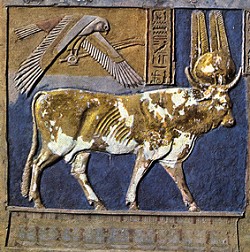
Greek name for the sacred bull of Hermonthis, to the south of Luxor. The bull had a black head and a white body, sometimes with a certain pattern of stripes. The classical author Macrobius records that the animal changed colour every hour. The animal was given various names, including 'Bech' (which perhaps means 'the eastern one') and ba-akh' ('shining Ba'). It was considered to be a form of the local god of Hermonthis, Montu, and was also called 'the living image of Montu'. Because of his relationship with Amun and the Ogdoad of Hermopolis, buried near Medinet Habu, Buchis could even be considered a primeval god. The bull was also linked with the sun god Re. Just as Apis was the 'Ba' of the god Ptah of Memphis, Buchis was seen as the living 'Ba' of Re and the Egyptian name of the animal is thus explained by the priests ('living Ba' is 'ba ankh' in Egyptian). This linked Buchis with the Mnevis bull of Heliopolis, who had the same title. In Hermonthis the burial place of the Buchis bulls has been found, the Bucheum, containing a number of large sandstone sarcophagi. The oldest burial there dates from the time of Nectanebo II, but there are indications that the site was already in use in the 18th Dynasty. Nearby has been found the burial place of the mothers of the Buchis bulls. The name of these animals ('Great Ihet who bore Re') again indicates the link between Buchis and the sun god, and also associates the cow herself with Amaunet. Buchis is depicted with the tall feathers of Montu on his head; a sun disk can often be seen between the horns.